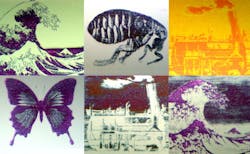Nanopixels promise high-resolution, thin, flexible displays
A team led by Oxford University scientists has made a new discovery that could make it possible to create pixels just a few hundred nanometers across that pave the way for extremely high-resolution and low-energy consumption, thin, flexible displays for applications such as 'smart' glasses, synthetic retinas, and foldable screens.
RELATED ARTICLE: Head-worn displays: Useful tool or niche novelty?
The team explored the link between the electrical and optical properties of phase change materials (materials that can change from an amorphous to a crystalline state). They found that by sandwiching a 7 nm thick layer of a phase change material (GST) between two layers of a transparent electrode they could use a tiny current to 'draw' images within the sandwich 'stack'. Initially still images were created using an atomic force microscope but the team went on to demonstrate that such tiny 'stacks' can be turned into prototype pixel-like devices. These 'nanopixels'—just 300 nm by 300 nm in size—can be electrically switched 'on and off' at will, creating the colored dots that would form the building blocks of an extremely high-resolution and flexible display technology.
A report of the research is published in Nature entitled “An optoelectronic framework enabled by low-dimensional phase change films”. While the work is still in its early stages, realizing its potential, the Oxford team has filed a patent on the discovery with the help of Isis Innovation, Oxford University's technology commercialization company. Isis is now discussing the displays with companies who are interested in assessing the technology, and with investors.
"We didn't set out to invent a new kind of display," said professor Harish Bhaskaran of Oxford University's Department of Materials, who led the research. “We were exploring the relationship between the electrical and optical properties of phase change materials and then had the idea of creating this GST 'sandwich' made up of layers just a few nanometres thick. We found that not only were we able to create images in the stack but, to our surprise, thinner layers of GST actually gave us better contrast. We also discovered that altering the size of the bottom electrode layer enabled us to change the colour of the image."
The layers of the GST sandwich are created using a sputtering technique where a target is bombarded with high energy particles so that atoms from the target are deposited onto another material as a thin film. "Because the layers that make up our devices can be deposited as thin films they can be incorporated into very thin flexible materials—we have already demonstrated that the technique works on flexible Mylar sheets around 200 nanometres thick,” said Professor Bhaskaran. “This makes them potentially useful for 'smart' glasses, foldable screens, windshield displays, and even synthetic retinas that mimic the abilities of photoreceptor cells in the human eye."
Peiman Hosseini of Oxford University's Department of Materials, first author of the paper, said, "Our models are so good at predicting the experiment that we can tune our prototype 'pixels' to create any colour we want—including the primary colours needed for a display. One of the advantages of our design is that, unlike most conventional LCD screens, there would be no need to constantly refresh all pixels, you would only have to refresh those pixels that actually change (static pixels remain as they were). This means that any display based on this technology would have extremely low energy consumption."
The research suggests that flexible paper-thin displays based on the technology could have the capacity to switch between a power-saving color e-reader mode and a backlit display capable of showing video. Such displays could be created using cheap materials and, because they would be solid-state, promise to be reliable and easy to manufacture. The tiny 'nanopixels' make it ideal for applications, such as smart glasses, where an image would be projected at a larger size as, even enlarged, they would offer very high-resolution.
Professor Bhaskaran said that the discovery would not have been possible without the support of the UK’s Engineering and Physical Sciences Research Council (EPSRC). The phase change material used was the alloy Ge2Sb2Te5 (Germanium-Antimony-Tellurium or GST) sandwiched between electrode layers made of indium tin oxide (ITO).
SOURCE: University of Oxford; http://www.ox.ac.uk/news/2014-07-10-nano-pixels-promise-thin-flexible-high-res-displays
About the Author

Gail Overton
Senior Editor (2004-2020)
Gail has more than 30 years of engineering, marketing, product management, and editorial experience in the photonics and optical communications industry. Before joining the staff at Laser Focus World in 2004, she held many product management and product marketing roles in the fiber-optics industry, most notably at Hughes (El Segundo, CA), GTE Labs (Waltham, MA), Corning (Corning, NY), Photon Kinetics (Beaverton, OR), and Newport Corporation (Irvine, CA). During her marketing career, Gail published articles in WDM Solutions and Sensors magazine and traveled internationally to conduct product and sales training. Gail received her BS degree in physics, with an emphasis in optics, from San Diego State University in San Diego, CA in May 1986.
